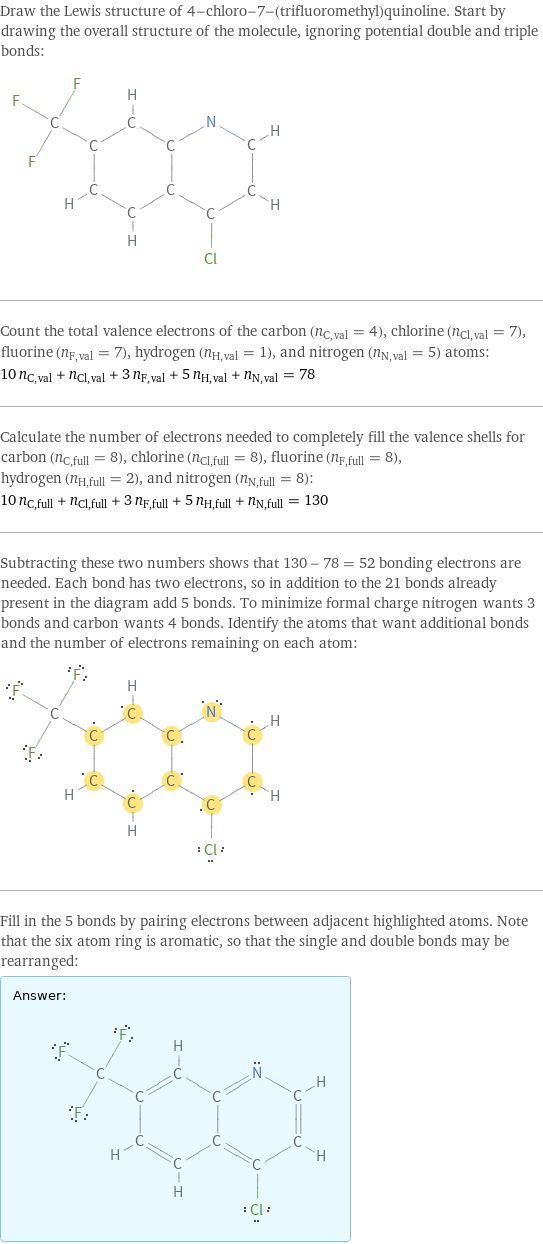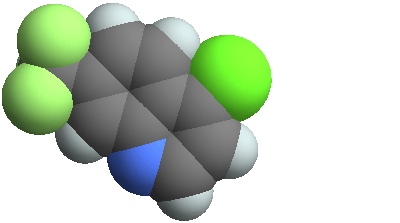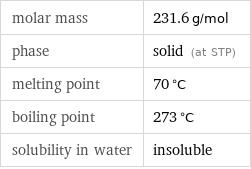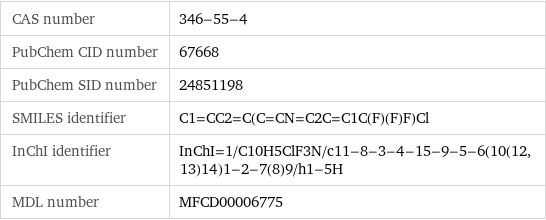Input interpretation

4-chloro-7-(trifluoromethyl)quinoline
Chemical names and formulas

formula | C_10H_5ClF_3N name | 4-chloro-7-(trifluoromethyl)quinoline alternate names | 4-chloro-7-trifluoromethyl quinoline mass fractions | C (carbon) 51.9% | Cl (chlorine) 15.3% | F (fluorine) 24.6% | H (hydrogen) 2.18% | N (nitrogen) 6.05%
Lewis structure

Draw the Lewis structure of 4-chloro-7-(trifluoromethyl)quinoline. Start by drawing the overall structure of the molecule, ignoring potential double and triple bonds: Count the total valence electrons of the carbon (n_C, val = 4), chlorine (n_Cl, val = 7), fluorine (n_F, val = 7), hydrogen (n_H, val = 1), and nitrogen (n_N, val = 5) atoms: 10 n_C, val + n_Cl, val + 3 n_F, val + 5 n_H, val + n_N, val = 78 Calculate the number of electrons needed to completely fill the valence shells for carbon (n_C, full = 8), chlorine (n_Cl, full = 8), fluorine (n_F, full = 8), hydrogen (n_H, full = 2), and nitrogen (n_N, full = 8): 10 n_C, full + n_Cl, full + 3 n_F, full + 5 n_H, full + n_N, full = 130 Subtracting these two numbers shows that 130 - 78 = 52 bonding electrons are needed. Each bond has two electrons, so in addition to the 21 bonds already present in the diagram add 5 bonds. To minimize formal charge nitrogen wants 3 bonds and carbon wants 4 bonds. Identify the atoms that want additional bonds and the number of electrons remaining on each atom: Fill in the 5 bonds by pairing electrons between adjacent highlighted atoms. Note that the six atom ring is aromatic, so that the single and double bonds may be rearranged: Answer: | |
3D structure

3D structure
Basic properties

molar mass | 231.6 g/mol phase | solid (at STP) melting point | 70 °C boiling point | 273 °C solubility in water | insoluble
Units

Chemical identifiers

CAS number | 346-55-4 PubChem CID number | 67668 PubChem SID number | 24851198 SMILES identifier | C1=CC2=C(C=CN=C2C=C1C(F)(F)F)Cl InChI identifier | InChI=1/C10H5ClF3N/c11-8-3-4-15-9-5-6(10(12, 13)14)1-2-7(8)9/h1-5H MDL number | MFCD00006775